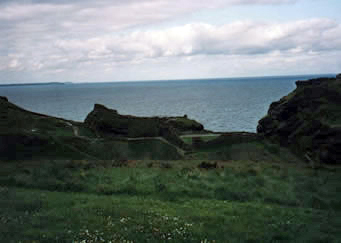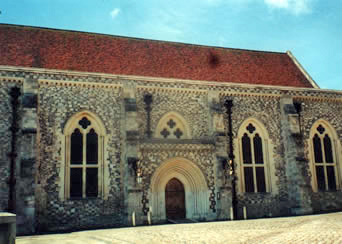Photographs of Arthurian Landmarks
Want to visit all the sites associated with King Arthur yourself?
Take a tour of Arthurian Britain through Scholarly Sojourns. |
| |
Arthurian Paintings | Children of Arthur Book Covers |
|
Left: Tyler Tichelaar in the maze at Hampton Court Palace in England.
Let me be your guide through the maze of Arthurian landmarks connected to the Arthurian legend.
All the photos below were taken during my visits to Great Britain in May-June 1993 and July 2000, during which time I visited many literary and Arthurian sites, gathering information for my Arthurian novels. Each site pictured below has long been traditionally associated with events from the Arthurian legends as you will discover. |
|
Right: Ruins of Tintagel Castle in Cornwall, the birthplace of King Arthur.
Tintagel was home to the Duke of Cornwall, Gorlois, who was married to the beautiful Igraine. King Uther lusted for Igraine, so Merlin cast a spell to disguise Uther to look like Gorlois so he could make love to Igraine. On that magical night, King Arthur was conceived. Because of his birth in Cornwall, Arthur is often referred to as the Boar of Cornwall in the Arthurian legends. While the castle now in ruins was built during the Middle Ages, archeology has shown a settlement may have existed here in Arthurian times (the sixth century). |

|
|
Arthur's family tree involves several Cornwall relatives although all their blood connections are not clear and differ from one retelling to the next. In general, Gorlois was probably the father to Morgan le Fay and Morgause, Arthur's half-sisters in most versions of the legend. Cador of Cornwall was also a relative, perhaps Arthur's cousin. At Arthur's death, Cador's son Constantine is Arthur's nearest male blood relation, although presumably on his mother's side, since Constantine inherits the kingdom.
The Tristan and Isolde subplot in the Arthurian legend depicts Isolde married to King Mark of Cornwall, who presumably was king over the Duke of Cornwall, and not related to King Arthur directly. |
|
|
|
Right: Stonehenge
Tradition holds that Merlin was the master builder of Stonehenge, magically bringing the stones from where they were located in Ireland to serve as a memorial for soldiers who died in wars against the Saxons, under the direction of Arthur's uncle King Aurelius Ambrosius. Aurelius, Uther, and Constantine are all traditionally said to have been buried here, and in at least one film version, Arthur is crowned here. |
|

|
Despite Merlin's reputed involvement and numerous other theories, the truth is that no one knows who built Stonehenge or why it was built. Most geologists agree that at least some of the stones came from the Prescelly Mountains in southwest Wales and probably were floated up the Bristol Channel on rafts.
Today, Stonehenge is roped off to the public to prevent vandalism. I actually found my visit to Stonehenge quite disappointing - I did not feel the magical, mystical experience I was anticipating, but it remains one of the great mysteries of history. |
|
Right: The Great Hall at Winchester, Home to the Round Table
Winchester was originally a Roman city but not really significant until Anglo-Saxon times when it became the capital of the Anglo-Saxon kingdom of Wessex under King Alfred the Great (reigned 871-899). The Great Hall is all that survives today of Winchester Castle, and it houses what is reputedly King Arthur's Round Table.
In Sir Thomas Malory's Le Morte d'Arthur, Winchester is equated with Camelot as Arthur's capital. |

|
|
Right: Interior of the Great Hall and the Round Table
From Anglo-Saxon times under King Alfred the Great through Norman times, Winchester was the capital of England. Winchester Castle was originally a fortress, but in time became a residence, especially under King Henry II (reigned 1154-1189), but by the end of King John's reign (1199-1216), Winchester was being superseded by London as the primary capital. Henry III (1216-1272) made it his primary home, during which it became a medieval palace. During the English Civil War, Cromwell had it destroyed so that only the Great Hall today remains. The Great Hall is now a museum with exhibits about the history of Winchester and the castle, as well as home to the Round Table. |
|
|
Right: The Round Table
The Round Table is the seat of King Arthur and his knights, being round so all would be equal and no one could sit at its head. In legend, Merlin has it constructed, and it was a great honor to be one of the knights allowed to sit at it.
The Round Table at Winchester is believed to have been made during the reign of King Edward I (1272-1307), who was known for his great interest in the Arthurian legend (see also below under the Glastonbury photos). The table has hung in the great hall since medieval times but was not painted until the reign of Henry VIII about 1522. The portrait of King Arthur was modeled after King Henry VIII's likeness, a way to reinforce the Tudor dynasty's claim to be King Arthur's heirs and possibly his descendants. |
|
|
Right: Stained Glass Windows in The Great Hall, Winchester
The Great Hall has numerous stained glass windows, containing the names and coats of arms of most of the medieval English monarchs as well as several noble families. The window depicted here contains the names of many Saxon kings including Edgar, Athelstan, and Cerdic. Interestingly, Cerdic's father, Cynric, King of Wessex is often depicted as King Arthur's enemy and reputedly was slain by him. One scholar, Geoffrey Ashe, however, has suggested Cerdic may have been King Arthur's son. |
|
|
|
Left: The White Tower at the Tower of London
The Tower of London was built following the Norman conquest of England by William I (reigned 1066-1087). However, Arthurian literature nevertheless uses it as a setting in the stories. Most notably, when King Arthur is fighting on the continent, Mordred tries to usurp the throne and attempts to force Queen Guinevere into marrying him; for protection, she locks herself within the Tower of London.
The White Tower is the oldest building of the larger Tower of London fortress and contains a beautiful Norman Chapel. Nearby is the Bloody Tower where the princes, Edward V and his brother Richard, were reputedly slain in 1483. Many were beheaded on the surrounding grounds, including Anne Boleyn. |
|
|
Left: The White Tower
A Celtic legend claims that Bran the Blessed, a Celtic King, had his head buried at the Tower of London. The head served as a type of charm to protect England. King Arthur, in his pride, had the head dug up because he believed only he was needed to defend England. The result was that pain and chaos fell upon England, resulting in Arthur and his son slaying themselves at the Battle of Camlann. |
|
|
Left: A Raven at the Tower of London
The Tower of London is famous for its raven family that has been there for centuries. A British legend claims, "If the ravens should leave, the White Tower will fall, and the power of Britain shall wane." One version claims Britain will lose its empire - the British empire is long gone but the ravens are still there.
While Arthur was reputedly taken to Avalon, in Don Quixote, a legend is mentioned that one should never kill a raven because King Arthur was turned into a raven at death. If that is the case, perhaps he is protecting the Tower of London today. |
|
Right: The Holy Thorn at Glastonbury Abbey
The Quest for the Holy Grail is a key part of the Arthurian legend, and Glastonbury is considered one of the oldest holy sights in England. It is here that St. Joseph of Arimathea reputedly brought the child Jesus to learn from the druids. Later, Joseph returned to Glastonbury and first brought Christianity to England. Joseph planted his rod in the ground and it became the Holy Thorn. During the Civil War, Cromwell ordered the thorn destroyed, but the child of the thorn pictured here remains at Glastonbury.
Arthurian genealogies often claim that King Arthur was descended from Joseph of Arimathea, who was believed to be Jesus' relative. |
|
|
Right: The Grave of Arthur and Guinevere
In 1191, the monks at Glastonbury Abbey reputedly discovered the grave of King Arthur and Queen Guinevere on the abbey's grounds. A cross also discovered stating the grave was theirs has since been reputedly lost, if it ever actually existed. King Henry II (1154-1189) was present at the event, and later King Edward I in 1274 asked that the grave be dug up again so he may see it. Many scholars believe the monks either faked the grave to get royal patronage, or else that King Henry II (being a Norman) engineered it as a way to prove to the conquered Saxon and Celtic peoples that King Arthur was dead and would not return. |
|
|
Right: Ruins of Glastonbury Abbey
Glastonbury has long been associated also with the Isle of Avalon, the mythical land where Arthur's sister, Morgan le Fay, took King Arthur after the Battle of Camlann so he could be healed from his womb. In Avalon, Arthur waits to return at the hour of Britain's greatest need. As a result, if Arthur were buried anywhere, Glastonbury Abbey was considered a likely place because of its association with Avalon. The place does have a mystical sense to it, and many claim it is a power source of magic, a sense I truly felt when I visited this sacred landscape. |
|
|
The ruins of Glastonbury Abbey are quite picturesque and the public is allowed to walk among them. When I visited in 1993, I had just finished reading Marion Zimmer Bradley's The Mists of Avalon so I was thrilled to be at the place she designated as just on the other side of the mists from Avalon. I did feel rejuvenated, as if some powerful energy was coming up from the ground at Glastonbury. If any place has Arthurian connections, or was ever home to the Holy Grail, Glastonbury seems like the most likely place to me. |
|
|
Historically, Glastonbury Abbey did have a Christian community dating back at least to the sixth century when King Arthur most likely lived. An old church at the site burnt in 1184, and the rebuilding of the abbey may have caused the monks to perform the publicity stunt regarding Arthur's grave to gain money to rebuild.
The Abbey's current ruins are the result of the English Reformation and King Henry VIII's dissolution of the monasteries in the 1530s. For more information about what may be my favorite Arthurian site, visit www.GlastonburyAbbey.com. |
|
|



